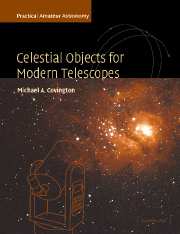Book contents
- Frontmatter
- Contents
- Preface
- Part I Amateur astronomy
- 1 Using this book effectively
- 2 Observing sites and conditions
- 3 The Moon, the Sun, and eclipses
- 4 The planets
- 5 Comets, asteroids (minor planets), and artificial satellites
- 6 Constellations
- 7 Stars – identification, nomenclature, and maps
- 8 Stars – physical properties
- 9 Double and multiple stars
- 10 Variable stars
- 11 Clusters, nebulae, and galaxies
- Part II 200 interesting stars and deep-sky objects
- Appendices
- Index
4 - The planets
Published online by Cambridge University Press: 22 September 2009
- Frontmatter
- Contents
- Preface
- Part I Amateur astronomy
- 1 Using this book effectively
- 2 Observing sites and conditions
- 3 The Moon, the Sun, and eclipses
- 4 The planets
- 5 Comets, asteroids (minor planets), and artificial satellites
- 6 Constellations
- 7 Stars – identification, nomenclature, and maps
- 8 Stars – physical properties
- 9 Double and multiple stars
- 10 Variable stars
- 11 Clusters, nebulae, and galaxies
- Part II 200 interesting stars and deep-sky objects
- Appendices
- Index
Summary
General concepts
The first thing a telescopic observer of the planets notices is that they all look rather small and blurry. Some training of the eye is required in order to see planetary detail. Not only are planetary features faint, but they require constant attention in order to take advantage of brief moments of steady air.
Drawing the planets is one of the best ways to learn to observe them (Figure 4.1). You can always see, and therefore draw, more detail than you can photograph with the same telescope. A good scale is about 5 cm (2 inches) for the diameter of the planet. Always draw what you see, not what you think you ought to see.
Every planetary drawing should be labeled with the date and time, particulars of the telescope, and eyepiece, and quality of seeing (atmospheric steadiness, Table 2.2, p. 12). Colored filters are often helpful. Such drawings have considerable scientific value and are collected for research purposes by the B.A.A. and A.L.P.O. (see p. 30).
Good handbooks for planet observers include, among others, Thomas A. Dobbins, Donald C. Parker, and Charles F. Capen, Introduction to Observing and Photographing the Solar System (Willmann–Bell, 1992), and Fred W. Price, The Planet Observer's Handbook (Cambridge, 1994). For current planetary research, see J. Kelly Beatty et al., The New Solar System (Cambridge, fourth edition, 1999; revised regularly).
- Type
- Chapter
- Information
- Celestial Objects for Modern TelescopesPractical Amateur Astronomy Volume 2, pp. 42 - 61Publisher: Cambridge University PressPrint publication year: 2002



